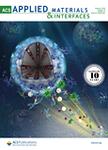版权所有:内蒙古大学图书馆 技术提供:维普资讯• 智图
内蒙古自治区呼和浩特市赛罕区大学西街235号 邮编: 010021

作者机构:Beijing Univ Chem Technol State Key Lab Organ Inorgan Composites Beijing 100029 Peoples R China Beijing Univ Chem Technol Beijing Adv Innovat Ctr Soft Matter Sci & Engn Beijing 100029 Peoples R China Anhui Normal Univ Coll Chem & Mat Sci Minist Educ Key Lab Funct Mol Solids Wuhu 241002 Peoples R China Hebei Univ Sci & Technol Sch Chem & Pharmaceut Engn Shijiazhuang 050018 Peoples R China
出 版 物:《ACS APPLIED MATERIALS & INTERFACES》 (ACS Appl. Mater. Interfaces)
年 卷 期:2025年第17卷第4期
页 面:6326-6336页
核心收录:
学科分类:0817[工学-化学工程与技术] 08[工学] 0805[工学-材料科学与工程(可授工学、理学学位)]
基 金:National Natural Science Foundation of China [52172179, 52073020, 52372074] National Natural Science Foundation of China [buctrc202118, buctrc202323] Fundamental Research Funds for the Central Universities
主 题:steric effect electrocatalytic CO2 reductionreaction structure-performance correlation tunable selectivity catalytic mechanism
摘 要:The comprehensive understanding of the effect of the chemical environment surrounding active sites on the pathway for the electrochemical carbon dioxide reduction reaction (eCO(2)RR) is essential for the development of advanced catalysts for large-scale applications. Based on a series of model catalysts engineered by the coordination of copper ions with various isomers of phenylenediamine [i.e., o-phenylenediamine (oPD), m-phenylenediamine (mPD), and p-phenylenediamine (pPD)] featuring two amino groups in ortho-, meta-, and para-positions, the steric effects could significantly govern the selectivity of the Cu-N sites for eCO(2)RR. It was found the steric distance between adjacent copper and nitrogen active sites in Cu-oPD enhanced the C-C coupling of the *COOH intermediate, thereby resulting in increased selectivity for C2H4 production. In contrast, the weak van der Waals interactions arising from steric electrostatic effects surrounding the *CHO intermediate on Cu-pPD facilitated subsequent hydrogenation, leading to the preferential synthesis of CH4. However, Cu-mPD exhibited diminished eCO(2)RR activity due to a higher free energy associated with the rate-determining step, which primarily led to the formation of H-2. This study underscores the significant role of a steric effect-driven selectivity switch for eCO(2)RR.